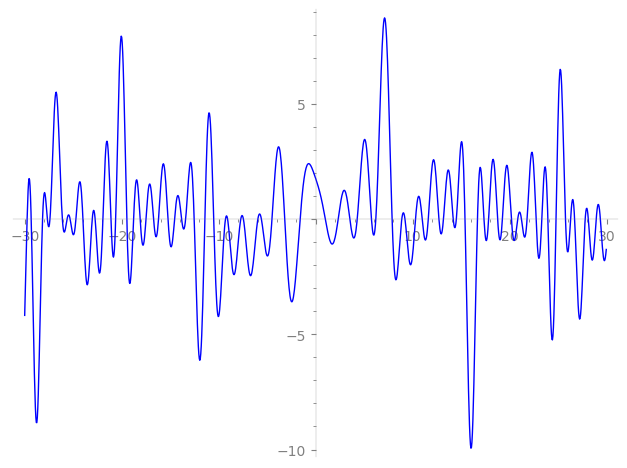| L(s) = 1 | + (0.105 + 1.41i)2-s + (0.380 − 0.219i)3-s + (−1.97 + 0.296i)4-s + 1.63·5-s + (0.349 + 0.513i)6-s + (0.866 + 0.5i)7-s + (−0.625 − 2.75i)8-s + (−1.40 + 2.43i)9-s + (0.171 + 2.30i)10-s + (0.958 + 1.65i)11-s + (−0.687 + 0.547i)12-s + (3.59 − 0.256i)13-s + (−0.614 + 1.27i)14-s + (0.620 − 0.358i)15-s + (3.82 − 1.17i)16-s + (2.70 − 4.68i)17-s + ⋯ |
| L(s) = 1 | + (0.0742 + 0.997i)2-s + (0.219 − 0.126i)3-s + (−0.988 + 0.148i)4-s + 0.729·5-s + (0.142 + 0.209i)6-s + (0.327 + 0.188i)7-s + (−0.221 − 0.975i)8-s + (−0.467 + 0.810i)9-s + (0.0541 + 0.727i)10-s + (0.288 + 0.500i)11-s + (−0.198 + 0.157i)12-s + (0.997 − 0.0711i)13-s + (−0.164 + 0.340i)14-s + (0.160 − 0.0925i)15-s + (0.956 − 0.292i)16-s + (0.655 − 1.13i)17-s + ⋯ |
Λ(s)=(=(728s/2ΓC(s)L(s)(−0.277−0.960i)Λ(2−s)
Λ(s)=(=(728s/2ΓC(s+1/2)L(s)(−0.277−0.960i)Λ(1−s)
| Degree: |
2 |
| Conductor: |
728
= 23⋅7⋅13
|
| Sign: |
−0.277−0.960i
|
| Analytic conductor: |
5.81310 |
| Root analytic conductor: |
2.41103 |
| Motivic weight: |
1 |
| Rational: |
no |
| Arithmetic: |
yes |
| Character: |
χ728(309,⋅)
|
| Primitive: |
yes
|
| Self-dual: |
no
|
| Analytic rank: |
0
|
| Selberg data: |
(2, 728, ( :1/2), −0.277−0.960i)
|
Particular Values
| L(1) |
≈ |
1.06036+1.41025i |
| L(21) |
≈ |
1.06036+1.41025i |
| L(23) |
|
not available |
| L(1) |
|
not available |
L(s)=p∏Fp(p−s)−1 | p | Fp(T) |
|---|
| bad | 2 | 1+(−0.105−1.41i)T |
| 7 | 1+(−0.866−0.5i)T |
| 13 | 1+(−3.59+0.256i)T |
| good | 3 | 1+(−0.380+0.219i)T+(1.5−2.59i)T2 |
| 5 | 1−1.63T+5T2 |
| 11 | 1+(−0.958−1.65i)T+(−5.5+9.52i)T2 |
| 17 | 1+(−2.70+4.68i)T+(−8.5−14.7i)T2 |
| 19 | 1+(1.50−2.61i)T+(−9.5−16.4i)T2 |
| 23 | 1+(−3.32−5.76i)T+(−11.5+19.9i)T2 |
| 29 | 1+(8.30−4.79i)T+(14.5−25.1i)T2 |
| 31 | 1+2.44iT−31T2 |
| 37 | 1+(−1.88−3.26i)T+(−18.5+32.0i)T2 |
| 41 | 1+(−8.34+4.81i)T+(20.5−35.5i)T2 |
| 43 | 1+(−9.67−5.58i)T+(21.5+37.2i)T2 |
| 47 | 1+0.314iT−47T2 |
| 53 | 1−1.36iT−53T2 |
| 59 | 1+(6.13−10.6i)T+(−29.5−51.0i)T2 |
| 61 | 1+(7.24+4.18i)T+(30.5+52.8i)T2 |
| 67 | 1+(1.26+2.19i)T+(−33.5+58.0i)T2 |
| 71 | 1+(14.4+8.33i)T+(35.5+61.4i)T2 |
| 73 | 1+10.2iT−73T2 |
| 79 | 1+1.03T+79T2 |
| 83 | 1−6.81T+83T2 |
| 89 | 1+(−6.37+3.67i)T+(44.5−77.0i)T2 |
| 97 | 1+(−1.88−1.09i)T+(48.5+84.0i)T2 |
| show more | |
| show less | |
L(s)=p∏ j=1∏2(1−αj,pp−s)−1
Imaginary part of the first few zeros on the critical line
−10.51626829849645448459845612067, −9.303495620125479733653135530535, −9.083045594993872280579959401165, −7.72870599124237769305226576995, −7.45293839069229785944752306287, −5.96689884809542896898436589187, −5.59803680708167554000592933979, −4.51000500809399939231900006496, −3.19487719636791079604011945348, −1.61072610961187008456816303551,
0.990773779252789091190887081715, 2.31328237743223257518102669065, 3.52179016065166877723016607223, 4.27507596887252682977602512840, 5.74631806658168566831701518394, 6.19244632346348262133754430068, 7.87456989610557211547427925847, 8.869665613396903915556807967706, 9.201418028178339427336872342582, 10.28502159664990562527975876148

